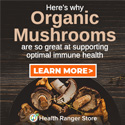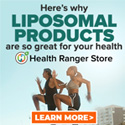
Negative Reactions to Antibiotics
Monday, December 01, 2008 by: Reuben Chow
Tags: antibiotics, health news, Natural News
- Newly released JFK files reveal Pentagon's role in creating Lyme disease and covid in the same lab
- Here are TEN all-natural ways to protect your garden without using harmful chemicals
- Ginseng's hidden anti-aging power: How compound K is rewriting the rules of skincare
- “Endgame: The Hidden Agenda 21” unveils a world of conspiracy and control
- L.A.'s rebuilding nightmare: Only 4 permits issued after fire destroys 6,000 homes
- Scientists demand FDA withdraw mRNA COVID vaccines amid contamination and gene therapy concerns
- Senate Democrats deny censorship industrial complex existed, defend government's role in silencing dissent
- Dr. Suzanne Humphries makes bombshell appearance on Joe Rogan podcast, exposing vaccine industry deception back to POLIOMYELITIS
- “The shame of Minnesota”: Somali immigrants behind $250 million child nutrition fraud in largest COVID-era scam
- Former Congresswoman exposes CCP's deep infiltration of California through universities, ports, and fentanyl
- Despite surge in MMR vaccination in Texas, measles outbreaks continue: Is VACCINE SHEDDING fueling the spread?
- PROCESSED TABLE SALT in foods found to fuel depression
- Chewing gum's dirty secret: How your daily habit could be flooding your body with microplastics
- “Independent” anti-Russia outlet MEDUZA faces COLLAPSE as US funding dries up
- BPA: The hidden hormone disruptor sabotaging your health - and how to fight back
- Embracing the wild: A deep dive into Jim Cobb’s “Backwoods Survival Guide”
- The hidden battle in your glass: How A1 and A2 milk could shape your health
- Catastrophic 7.7 earthquake devastates Myanmar and Thailand; death toll could reach 100,000
- Newly released JFK files reveal Pentagon's role in creating Lyme disease and covid in the same lab
- Analysis: The coming economic collapse, a mass uprising and Trump's three secret weapons to halt the growing revolt
- Festive flavors: The sweet history, nutritional profile and health benefits of pecan pie
- Elon Musk: Aliens could be here on Earth RIGHT NOW
- Trump reverses course on Gaza plan, says “nobody is expelling Palestinians”
- Big Pharma's $8 Billion bribery scheme exposed: how doctors are pushed to prescribe junk science, not heal
- Boys are back in town: Trump’s patriotic alpha crew takes the wheel while toxic females ride in the backseat
- Reclaim your health: How midlife exercise reverses years of inactivity
- A lack of integrity in Academia: Harvard professor found GUILTY of fraudulent research to promote CRT theory
- Survival 101: Effective EMF blocking techniques
- EPA advisor admits the agency is funneling billions to climate groups ahead of Trump’s return to White House
- Dr. Mike Yeadon releases 15-minute testimony - WATCH - about genocidal intent of COVID “vaccines”
- 5 Simple steps to boost your brainpower: How to strengthen executive function in a distracted world
- Florida takes a stand: DeSantis proposes permanent ban on mRNA vaccine mandates
- Sugarcane extract superior to cholesterol-lowering drugs?
- Mike Adams Sermon 66: God will DESTROY ISRAEL for its wickedness
- Pilots report mysterious lights 'moving at extreme speeds' across Oregon skies
- Space war brewing? Russia threatens to destroy Starlink satellites
- EPA advisor admits the agency is funneling billions to climate groups ahead of Trump’s return to White House
- California's social media censorship law struck down: A victory for free speech or a threat to online safety?
- The Health Ranger releases “Vaccine Zombie” song and music video, using AI-animated zombies for the music video
- Dr. Mike Yeadon releases 15-minute testimony - WATCH - about genocidal intent of COVID “vaccines”
- The pandemic as a tool for INDOCTRINATION: Understanding “The Indoctrinated Brain” by Dr. Michael Nehls
- Newly released JFK files reveal Pentagon's role in creating Lyme disease and covid in the same lab
- Florida takes a stand: DeSantis proposes permanent ban on mRNA vaccine mandates
- Mike Adams releases country western hit single: Goin’ Back in Time is Comin’ Home
- Mike Adams releases music poetry sensation: A Child of God
- “Why we influenced the 2020 elections”: Facebook files reveal the coordinated effort to bury the Hunter Biden laptop story
- Unpacking the Lies That We’ve Been Fed – new song and music video released by Mike Adams, the Health Ranger
- RFK Jr. clears key hurdle: Sen. Susan Collins backs controversial HHS nominee, signaling a new era for health policy
- Mike Adams releases new song and music video: Nothing More Disgusting Than a Globalist
- Michigan sheriff announces criminal investigation into 2020 election crimes, Dominion Voting Systems
- Israeli soldiers accused of even more torture and abuse in the West Bank
- Migrants are taking advantage of recent hurricanes to scam residents and loot their homes
- House Intelligence Committee calls for the ARREST and PROSECUTION of Dr. Anthony Fauci
- Rep. Nancy Mace introduces bill to ban biological males from female facilities on federal property
- Red Cross issues warning to stop blood plasma donations from vaccinated people
- Scientists confirm: GENIUS brain function can be spontaneously unleashed in humans without any apparent cause
- EPA advisor admits the agency is funneling billions to climate groups ahead of Trump’s return to White House
- HYSSOP: What research reveals about the health benefits of this ancient holy herb
- Two containers with completed ballots fall out of truck in Florida
- Fully vaccinated about to see “tsunami” of illness and death, warns virologist
- Global leaders unite to clamp down on “misinformation” with UN-backed Cascais Declaration
- BREAKING: 2025 NDAA authorizes mandatory military draft of WOMEN across America… as Pentagon pursues global NUCLEAR war with both Russia and China at the same time
- Michael Yon warns of a ZIONIST TAKEOVER in Trump’s second administration
- BOMBSHELL: DNA testing kits are a SCAM to develop ethnic-specific bioweapons
- Ozempic and Wegovy weight loss drugs are injectable LIZARD VENOM PEPTIDES that may unleash a devastating wave of organ failure… side effects align with symptoms of SNAKE BITES
- Israeli soldiers accused of even more torture and abuse in the West Bank
- These 13 countries just signed an agreement to engineer a global FAMINE by destroying food supply
- NASA admits that climate change occurs because of changes in Earth’s solar orbit, and NOT because of SUVs and fossil fuels
- RFK Jr. clears key hurdle: Sen. Susan Collins backs controversial HHS nominee, signaling a new era for health policy
- Sermon 30: How Jesus reveals Caesar’s FAKE CURRENCY and FALSE AUTHORITY
- Coriander seeds: Ancient medicine backed by modern science
- Arizona officials claim Maricopa County needs 10-13 days to tabulate results of the election
Details of the Study
For the study, the first of its kind in the US, the researchers examined the extent of negative reactions to systemic antibiotics, which are those ingested or injected, as supposed to topical creams.
The study team looked at outpatient prescriptions from national sample surveys of the National Ambulatory Medical Care Survey and the National Hospital Ambulatory Medical Care Survey (2004-2005), as well as drug-related adverse events from the National Electronic Injury Surveillance System-Cooperative Adverse Drug Event Surveillance project (2004-2006). The latter used a sample of 63 US hospitals.
From the data, it was found that bad reactions to antibiotics resulted in 6,614 visits to the ED. This figure was extrapolated to reach an estimated 142,505 antibiotic-related emergency cases for the whole country. Out of all ED visits for drug-related adverse events, antibiotics took the blame for about 19% of them.
The study, published in the September 2008 issue of Clinical Infectious Diseases, also found that about 78% of the cases involved allergic reactions to the prescribed antibiotics, including rashes and a serious reaction known as anaphylaxis. The other causes included accidental overdoses, unintentional exposures (for example children who chanced upon the antibiotics and ingested them), as well as side effects like headaches, dizziness and diarrhea.
Most of those affected –- more than 40% -- were aged 15 to 44. About 6% were infants.
The Main Culprits
Despite being generally seen as safe and widely used, penicillin and similar-type antibiotics accounted for a significant chunk of this particular distasteful pie. The study team wrote that about half of the estimated ED visits could be attributed to penicillins (36.9%) and cephalosporins (12.2%).
In terms of the rate of ED visits, meaning the number of ED visits for every 10,000 outpatient prescription visits, sulfonamides and clindamycin, also commonly prescribed antibiotics, scored the highest at 18.9 and 18.5 respectively.
Sulfonamides were also responsible for a markedly higher rate of moderate-to-severe allergic reactions (4.3%, compared to 1.9% for all other antibiotic classes). In addition, sulfonamides and fluoroquinolones were linked to a higher rate of neurological or psychiatric disturbances (1.4% vs. 0.5%).
Moving Ahead
Most of us are aware that antibiotics are used very often. "Antibiotics are among the most frequently used medications in the United States. Annually, antibiotics are prescribed to an estimated 16 percent of patients during ambulatory care visits, and pharmaceutical manufacturers spend $1 billion promoting antibiotics," wrote Dr Daniel S. Budnitz, the leader of the study.
And many of us are also aware that antibiotics tend to be overused and wrongly used. In fact, some doctors willingly prescribe them when these drugs are requested by patients, even though there might not be any need to take them at all. According to the study report, "more than one-half of the estimated 100 million antibiotic prescriptions written in the community each year for respiratory tract infections may be unnecessary". This is because many of such infections are caused by viruses, against which antibiotics are of no use. And, as noted in a commentary by Jeffrey A. Linder from Brigham and Women's Hospital and Harvard Medical School, the risks to the individual patient are greater than the benefits, and "the discussion should stop there".
Yet, it seems, many doctors still hold the view that their patients would be exceptions and thus continue to prescribe antibiotics. And this mindset has contributed greatly to the current undesirable situation.
Add in the fact that antibiotics, like all drugs, have their fair share of side effects, and we have a recipe for disaster. And now that we have a tangible feel of the actual damage and the immediate and direct risks to individual patients, something needs to be done.
Doctors and patients alike need to take responsibility and use antibiotics only when absolutely necessary. "This number is an important reminder for physicians and patients that antibiotics can have serious side effects and should only be taken when necessary," said Budnitz.
And, every little reduction in antibiotic use would have a marked impact.
Budnitz summed it up well when he said, "Because antibiotics are frequently used, both appropriately and inappropriately, if doctors would reduce the number of antibiotics they prescribe to their patients by even a small percentage, we could significantly reduce the number of emergency visits for antibiotic adverse events."
Main Sources
Emergency Department Visits for Antibiotic-Associated Adverse Events (http://www.journals.uchicago.edu/doi/abs/10....)
Study Finds 140,000 Bad Reactions to Antibiotics (http://abcnews.go.com/Health/WireStory?id=55...)
Antibiotics for Treatment of Acute Respiratory Tract Infections: Decreasing Benefit, Increasing Risk, and the Irrelevance of Antimicrobial Resistance (http://www.journals.uchicago.edu/doi/full/10...)
About the author
Reuben Chow has a keen interest in natural health and healing as well as personal growth. His website, All 4 Natural Health, offers a basic guide on natural health information. It details simple, effective and natural ways, such as the use of nutrition, various herbs, herb remedies, supplements and other natural remedies, to deal with various health conditions as well as to attain good health. His other websites also cover topics such as depression help, omega 3 fatty acids, as well as cancer research and information.Antibiotics at FETCH.news
Get independent news alerts on natural cures, food lab tests, cannabis medicine, science, robotics, drones, privacy and more.
Take Action: Support Natural News by linking to this article from your website
Permalink to this article:
Embed article link: (copy HTML code below):
Reprinting this article:
Non-commercial use OK, cite NaturalNews.com with clickable link.
Follow Natural News on Facebook, Twitter, Google Plus, and Pinterest
Science News & Studies
Medicine News and Information
Food News & Studies
Health News & Studies
Herbs News & Information
Pollution News & Studies
Cancer News & Studies
Climate News & Studies
Survival News & Information
Gear News & Information
News covering technology, stocks, hackers, and more



"Big Tech and mainstream media are constantly trying to silence the independent voices that dare to bring you the truth about toxic food ingredients, dangerous medications and the failed, fraudulent science of the profit-driven medical establishment.
Email is one of the best ways to make sure you stay informed, without the censorship of the tech giants (Google, Apple, Facebook, Twitter, YouTube, etc.). Stay informed and you'll even likely learn information that may help save your own life."
–The Health Ranger, Mike Adams












































